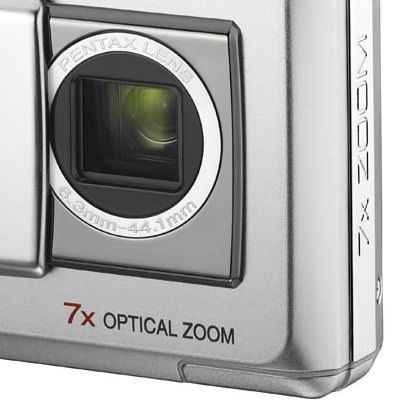Out of the box, only a sliding front lens cover that also turns the camera on and off spoils the slim lines. The top plays host to one button, the shutter release while the back houses a nice, 2.5-inch, 230K-pixel colour screen, the easy to use zoom buttons a playback button and the ubiquitous four-way jog buttons. A menu and green mode button complete the ensemble.
Our quick take
This is nicely made point and shoot digital camera comes with a few extra bells and whistles ringing the changes for Pentax, but it is also one with a few bells and whistles missing, ones that really should have been there to ring out loud and clear.
Image quality is okay but hampered by noise, unless this camera is discounted quickly, it is hard to see how it can compete.

Pentax Optio Z10 digital camera - 3.5 / 5
| FOR | AGAINST |
|---|---|
|
|
As usual, the four-way buttons provide scrolling and navigation in playback and menus respectively but also double up for drive modes, such as the self timer (top segment), flash modes (right segment), the shooting mode (bottom segment) and finally (right hand segment) the focus modes AF, manual and macro for example.
On the base, we find the hatch that cover s the port for the SD/SDHC external storage and the hatch for the battery, a rechargeable 700mAh lithium-ion affair.
So far so ordinary. The camera’s 8-megapixel sensor is a tiny, 1/2.5-inch CCD, so pixels are packed more tightly than the proverbial sardines, and, as we’ll see later, this can have an adverse affect on picture quality. What is quite neat is the fact the 7x optical zoom is a non-protruding lens, it moves vertically, periscope fashion, inside the body of the camera.
But a camera with this vertical zoom design, with a long zoom ratio of the 35mm film equivalent of a 38-266mm lens, is going to be very prone to camera shake. The Z10 does have a Digital SR (Shake Reduction) mode, but this simply bumps the ISO up to its highest to bring faster shutter speeds into play. There’ no “real” shake reduction at work at all.
The other issue is this SR mode also uses the top ISO 3200 mode and as discussed earlier, such small sensor can be prone to noise. But I’m getting ahead of myself once again. Other neat kit you do get is manual adjustments for sharpness, saturation and contrast, three very reliable metering modes of evaluative, centre-weighted and spot and dual AF modes including the new must have item on a digital camera Face Recognition AF/AE.
Here the Pentax system can recognise up to 15 faces in a shot and it works very quickly indeed; Pentax claims 0.03-seconds and on my tests that seems fair. It will only work when the camera is set to a relevant shooting mode (Kids or Portrait for example) and only works well when the cameras is directly facing peoples', um, faces!
Other nice touches include the flash, which for a camera of this ilk seems remarkably powerful with a frame coverage that does justice to the shot you’re taking, particularly at the wide end of the lens. A video mode is included (of course, what camera would be without these days?) and it provides 640 x 480 (VGA) resolution movies at 30fps with mono sound, disappointingly however, you cannot zoom the lens during filming.
The Auto Picture mode is quite fun too as it will assess the scene you’re about to shoot and pick the appropriate camera mode accordingly: landscape for landscape mode and so on. This is a great point and shoot feature and takes the headache out of point and shooting, if there was one of course.
Okay, so handling and features are combination of the ordinary and not so ordinary, what of the all important image quality? The new lens design had to be good to cope with this camera’s pixel-packed and tiny sensor and to a large degree it copes well. Yes there is blue and purple fringing in some high contrast areas of some shots (it even bleeds into shadows on some of my shots, so perhaps, not quite so good), but at lower ISOs detail is good as can be seen in my shot of two old petrol pumps on a farm. Dials are clearly readable on the full resolution image.
Metering and focusing are good and while colours become muted, the higher the ISO goes they’re on the natural side of vivid, so punchy without being artificial. But noise is the real problem. It’s evident in all my shots, even those at lower ISOs (the sensitivity range, by the way, is a good one from ISO 64 to 3200) but it becomes very bad over ISO 400 and above ISO 800 horrible with ISO 3200 images (the so-called Shake Reduction setting) just about useless.
Another worry must be the lack of a proper anti shake feature given this camera’s launch price of £170. Competitors including Casio’s cheaper EX-V7 and Panasonic’s TZ2 both come with a reasonably effective (mechanical) anti shake system, which puts this Pentax further onto its back foot.
To recap
Image quality is okay but hampered by noise, unless this camera is discounted quickly, it is hard to see how it can compete
